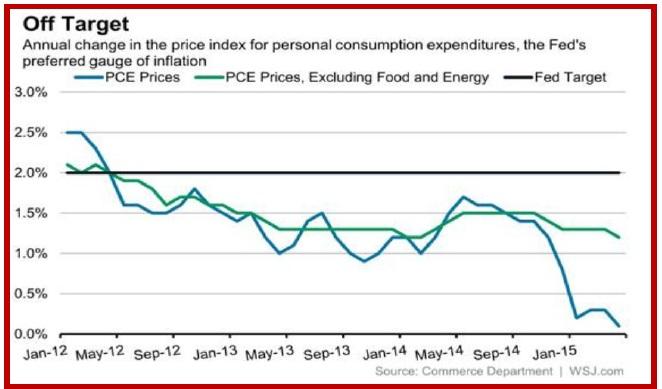Outlook:
The seeming resumption of the euro pullback to the upside is not really a surprise. It was always a realistic possibility, although we would be more comfortable having a hard, cold reason for it. The only explanation we have found--a rise in Bund yields—would be okay if the spread were not at the same time widening in the US’ favor. Theory has it that it’s the spread that counts. And why is the Bund yield rising in the first place? Yields rise when prices fall, implying some factor is driving safe-haven seekers out. Maybe a deal with Greece is realistic, after all. In a data-overload week, today in the US we get auto sales, Redbook chain store sales and factory orders, of which auto sales speak to consumer confidence and factory orders speak (maybe) to rising employment and exports.
But we want to think about inflation. The personal consumption expenditures price index rose 0.1% y/y in April, the lowest since Oct 2009 and less than 0.3% in both Feb and March. The PCE price index is reportedly what the Fed prefers to look at, and it ain’t good. The WSJ notes that “April 2012 was the last time the inflation rate was on target. That’s the longest such stretch of sub-2% inflation since the 1960s.”
And core inflation, ex energy and food, was up 1.2% y/y in April—but 1.3% in the earlier four months. Economists like Ian Shepherdson tell us not to worry about it—the tight labor market means future inflation is in the cards. “It won’t be current inflation that prompts the first Fed hikes, it will be the tightness of the labor market and the signal it sends about future inflation risk, given the extraordinarily easy stance of policy.”
But see the chart below. Does this look like a rate hike to you?
Not to Boston Fed Pres Rosengren. He’s a non-voter but worries that the lousy Q1 performance means conditions are not close to being right for a hike. Rosengren was talking about GDP at -0.7%, but the hipbone is connected to the thigh-bone. Slow growth means price pressure is soft. Maybe the Q1 result was due to temporary factors like the weather and port strike, but maybe it’s “a reflection of broader changes in the economy.” Rosengren said “…an appropriately data-dependent monetary policy requires confirmation in the numbers, not just in forecasts of better times.” Besides, the Fed has no wiggle room to retreat if a new shock comes along, including a shock from foreign shores, Europe or China.
Delay past September is starting to look realistic.
Right now the action is pro-euro, not anti-dollar, except for the base-case anti-dollar sentiment that has pervaded the FX market for decades. But even though we still have the divergent monetary policy scenario that has the dollar the beneficiary of rising rates while everyone else is in QE, it’s looking a little threadbare just now.
It’s also not working, at least not today. As we have written all too many times before, the yield spread has to give the dollar a fat premium to overcome anti-dollar bias, probably 250 bp. If the Bund yield rises, it’s safe for the dollar only if that cushion has been built in. And it’s not getting built in. This is pretty scary. Right now, it looks like the euro can continue to rally to the previous intermediate high, 1.1208 from May 22. This is beyond the breakout bar mid-point but would still allow the bigger dollar rally to exist. Beyond the 1.208 level, we would have to re-think what’s going on.
This morning FX briefing is an information service, not a trading system. All trade recommendations are included in the afternoon report.
Recommended Content
Editors’ Picks
EUR/USD holds steady near 1.0650 amid risk reset

EUR/USD is holding onto its recovery mode near 1.0650 in European trading on Friday. A recovery in risk sentiment is helping the pair, as the safe-haven US Dollar pares gains. Earlier today, reports of an Israeli strike inside Iran spooked markets.
GBP/USD recovers toward 1.2450 after UK Retail Sales data

GBP/USD is rebounding toward 1.2450 in early Europe on Friday, having tested 1.2400 after the UK Retail Sales volumes stagnated again in March, The pair recovers in tandem with risk sentiment, as traders take account of the likely Israel's missile strikes on Iran.
Gold: Middle East war fears spark fresh XAU/USD rally, will it sustain?

Gold price is trading close to $2,400 early Friday, reversing from a fresh five-day high reached at $2,418 earlier in the Asian session. Despite the pullback, Gold price remains on track to book the fifth weekly gain in a row.
Bitcoin Price Outlook: All eyes on BTC as CNN calls halving the ‘World Cup for Bitcoin’

Bitcoin price remains the focus of traders and investors ahead of the halving, which is an important event expected to kick off the next bull market. Amid conflicting forecasts from analysts, an international media site has lauded the halving and what it means for the industry.
Geopolitics once again take centre stage, as UK Retail Sales wither

Nearly a week to the day when Iran sent drones and missiles into Israel, Israel has retaliated and sent a missile into Iran. The initial reports caused a large uptick in the oil price.
